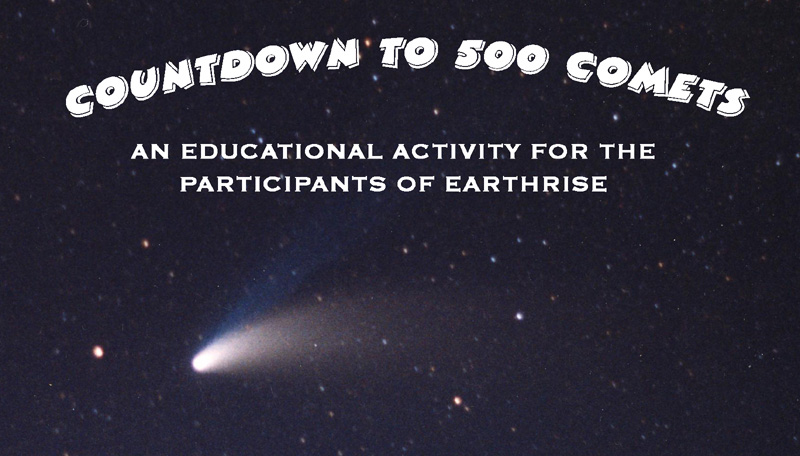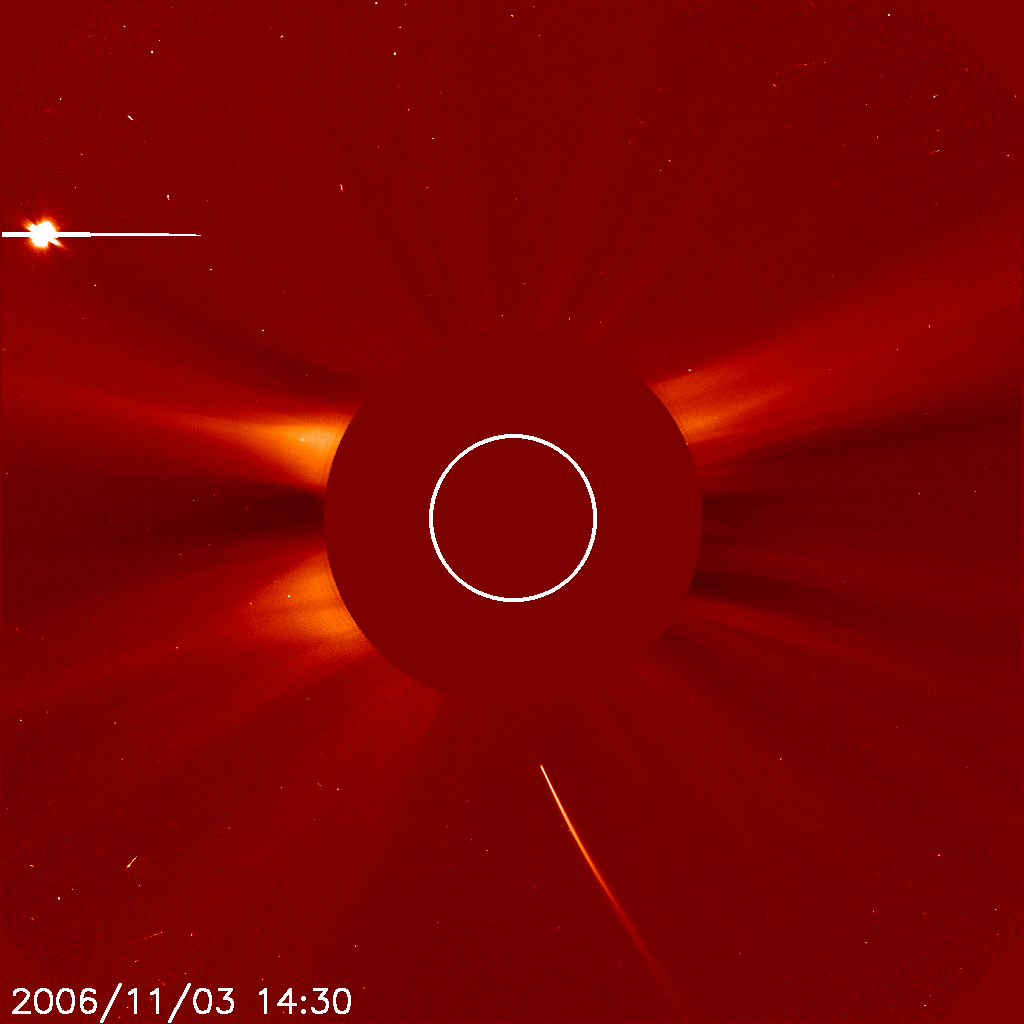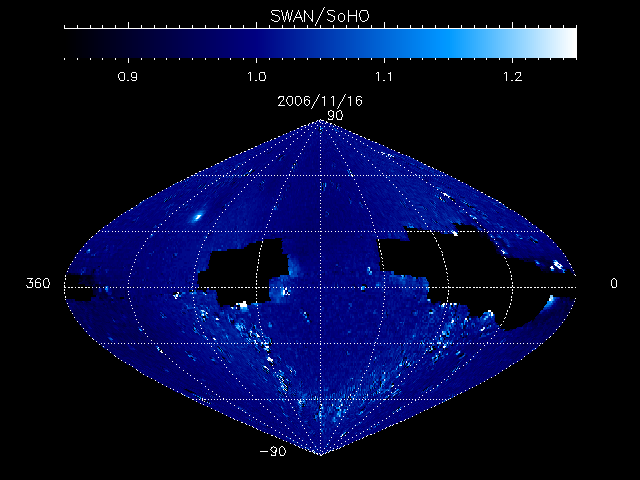
Most of my comet observing is done with a Meade DS-16 16-inch (41 cm) telescope that I have owned since 1987 -- the Hale-Bopp discovery telescope, in fact. I also utilize some smaller telescopes, as well as the telescopes owned by the Earthrise Institute and, when the comets involved are bright enough, binoculars and my unaided eye. On an average night, between two and four comets are visible with the DS-16 scope, although this varies widely; on occasion (although usually quite rare) no comets are visible, whereas on one occasion in early 1996 I observed as many as eleven comets in one night. The average comet remains in view for approximately three months, although this also varies quite dramatically; there are some comets that I've only been able to view once, and there have been a handful that I've been able to follow for two or three years or more.
Up until the fairly recent past, many, if not most, comets were discovered by dedicated individuals who constantly swept the skies looking for new comets. While perhaps not entirely gone forever, those days are all but over now; nowadays the vast majority of comets are discovered by comprehensive all-sky surveys that are primarily searching for near-Earth asteroids but which are also finding many comets as a significant by-product. (For a list of these surveys and links to their respective web sites, go to the Minor Planet Center's NEO page and scroll to the bottom.) As many as 40 to 50 new comets are being discovered each year by these surveys, although most of these are very dim and distant objects that I don't even consider looking for. On the average -- although, again, this can vary quite a bit -- approximately ten comets are discovered each year that are bright enough for me to observe. Also, each year between five and ten expected periodic comets become bright enough for me to observe. When one includes comets that are "carried over" from preceding years, I thus end up observing approximately 20 comets each calendar year, on the average. (My record is 34.)
By "observe," I mean detecting a comet visually through the eyepiece of a telescope (or with binoculars or the unaided eye). In doing so, one can examine the comet for structure (tail development, etc.) and also make measurements of its brightness, or magnitude. (See the International Comet Quarterly's glossary page for a definition of magnitude and other terms that one encounters in cometary astronomy, and their magnitude scale page which gives specific examples.) One can also take CCD images of comets, in part to measure their positions for use in orbit calculations (an activity called "astrometry"); I did this quite extensively as part of the Institute's activities for several years earlier this decade, and expect to do so again once the Earthrise telescopes are up and operating.
I'll give basic information about currently observable comets on the update page, and to the comet tally pages every time I add a new comet to my "observed comets" list. One can calculate "ephemerides" (i.e., lists of tabulated positions the comet will occupy at given times) on the IAU's comet ephemeris page. Brightness measurements of currently observable comets (including some by me) are often posted at the ICQ's comet brightness page, the Comet Observation Home Page [currently inactive], and the Yahoo! comet observations group. The Yahoo! comets mailing list will often carry discussions about current comets, and links to images are often given at the Yahoo! comet images group. For basic information about how to observe comets, see the International Comet Quarterly's main page, and examine some of its recommended sources of information.
As far as equipment goes, a good telescope (and a good pair of binoculars) are probably essential. It is best to be located in a dark viewing site, although I realize for many of the participants of this activity this isn't practical. (Those who observe from light-polluted areas will thus probably be restricted to observing the brighter comets, but these are also in many cases the most interesting.) A good star atlas is very helpful, although with today's computer-aided telescopes one can often dial-in the coordinates from an ephemeris and the telescope will take you right to the correct location. Still, especially when trying to detect a very faint comet, it can be helpful to compare the field you see in the telescope's eyepiece with what you should expect to see; one source that's very useful in observing faint comets are the sky fields that are accessible via the Digitized Sky Survey.
There are a couple of issues I should address when discussing the comets I observe. There are many comets that are short-period objects (most of which have orbital periods in the range of six to eight years), and over time I've observed many of these objects on different returns. I count the separate returns of these comets as separate comets, for tally purposes. I've seen Comet 2P/Encke, for example, on nine separate returns so far, so in the tally of my first 400 comets it shows up nine different times. (I'll almost certainly see it on one return, and possibly one or two more, during these next 100 comets.) There are a handful of additional comets that I've seen four or five times each, and quite a few that I've seen two or three times each. (For the record, the first 400 "comets" includes 304 separate objects.)
There are two significant types of objects that I do not count as comets in my tally. First, I do not count separate components of comets that have split into two or more pieces. For example, in early 2006 Comet 73P/Schwassmann-Wachmann 3 was seen to fragment into a large number of pieces (over 60!), and in addition to the primary component (designated component C) I successfully observed three additional fragments (components B, G, and R) as separate entities; however, I count all these as being only one comet. Second, there are numerous objects being discovered that appear to be asteroids but which are traveling in distinctly cometary orbits and which may in fact be "extinct" or "dormant" comets. I try to observe these whenever one becomes bright enough for me to detect, but I do not count these as comets if and when I do observe them. However, if subsequent observations (usually made with large telescopes) detect cometary activity, then they are classified as comets and thus are eligible for my tally if I have observed them. I've already added one such comet to my tally retroactively, and it is conceivable that some of the other cometary "asteroids" I've already observed may turn out to be comets and thus they'll get added to my list as well.
I also do not include comets that I've imaged with the Institute's CCD system but which I haven't detected visually. I've found that CCD imaging can sometimes help in detecting extremely faint comets visually, but many of the comets I've imaged (and expect to image in the future) are simply too faint for visual observation.
On the update and tally pages I'll list the comets by their designations and their names. The designation scheme presently in use was instituted at the beginning of 1995 and is described on the appropriate IAU page. The longstanding tradition, from which I have benefited, is that comets are named for their discoverers; however, especially in these days of comprehensive automated surveys, the term "discoverer" is not necessarily clear-cut. Many comets nowadays receive the names of the observatory where they were discovered or the program under which they were found; quite a few of these are acronyms. If one is interested, one can check the IAU's official comet naming guidelines, and the International Comet Quarterly (ICQ) has an interesting discussion on the entire issue of designations and names.

Interested participants can examine near-real time images taken with the coronagraphs to see if there are any comets. Go to the SOHO web site; images taken with the LASCO C2 and C3 coronagraphs are the last two lists on the bottom row. There is a special web site specifically devoted to information (including report forms) about the SOHO comets, as well as a Yahoo! discussion group devoted to the topic.
A recent example of one of the SWAN images is shown at right. Comet C/2006 M4 is the bright, somewhat fuzzy object in the upper left quadrant of the image.
